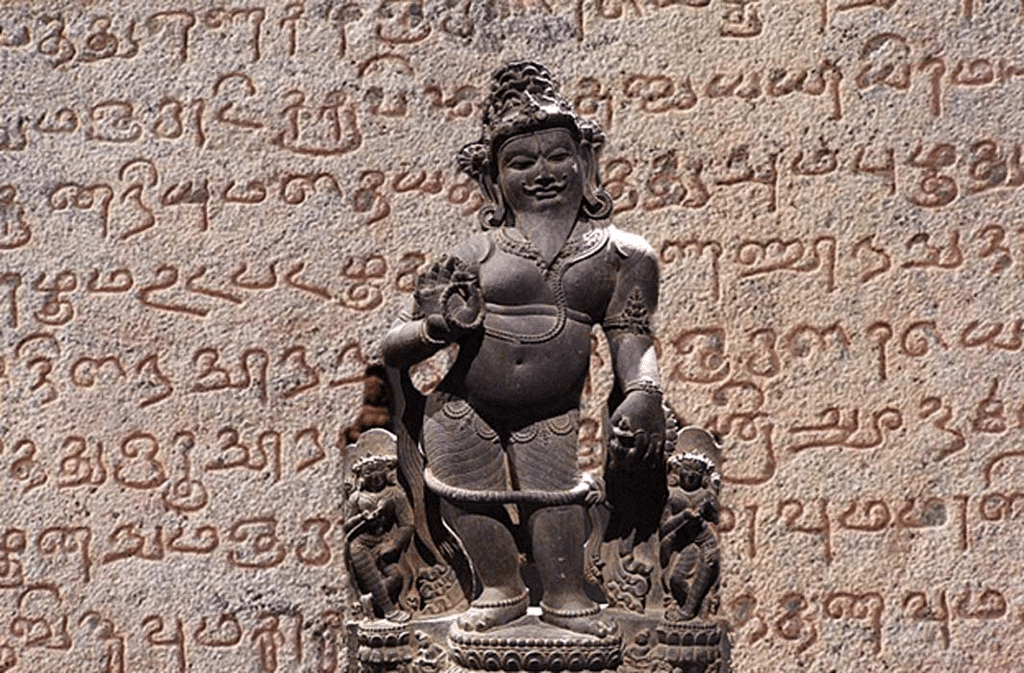The Ancient Tamil Siddhar Agastyar is traditionally believed to have chaired the first Tamil Sangam in Madurai.
 The Sangam Literature
The Sangam Literature
- The period roughly between the 3rd century B.C. and 3rd century A.D. in South India (the area lying to the south of river Krishna and Tungabhadra) is known as Sangam Period.
- It has been named after the Sangam academies held during that period that flourished under the royal patronage of the Pandya kings of Madurai.
- At the sangams eminent scholars assembled and functioned as the board of censors and the choicest literature was rendered in the nature of anthologies.
- These literary works were the earliest specimens of Dravidian literature.
- According to the Tamil legends, there were three Sangams (Academy of Tamil poets) held in the ancient South India popularly called Muchchangam.
1. The First Sangam, is believed to be held at Madurai, attended by gods and legendary sages.
2. The Second Sangam was held at Kapadapuram, only Tolkappiyam survives from this.
3. The Third Sangam was also held at Madurai. A few of these Tamil literary works have survived and are a useful sources to reconstruct the history of the Sangam period
Try yourself:The First Sangam, is believed to be held at _____
- The Agattiyam was written by saint Agattiyar, is now extent in small shreds of sutras here and there, quoted by medieval commentators.
- The Tolkappiyam was written by Tolkappiyar, supposed to be a disciple of Agastya and a contemporary of eleven other scholars who were all disciple of the same Rishi.
- It is a work on Tamil grammar, literary tradition and sociology.
- Purapporul Venba Malai, a medieval work on the grammar of the Puram literature, says that the twelve scholars jointly produced Pannirupadalam, a grammatical work on Puram literature.
- The Kakkaipadiniyam, an extinct work on prosody, is also ascribed by tradition to that period.
- Traditionally, Tolkappiyam is supposed to lay down the grammatical rules which governed the literary compositions of the Sangam age.
- The sutras of the Tolkappiyam are elaborate and extensive in range.
- Orthography, construction, prosody, figures of speech, social practices, literary conventions, human psychology in so far as it relates to epic and dramatic literature, the grammar of the Aham (love) and Puram (war) and the allied conventions are set forth in detail in this work.
- It is schematic and divided into three sections, each consisting of nine sub-chapters.
Try yourself:
The Tolkappiyam was written by ______
- The word ‘Sangam’ for the early Tamil literature was mentioned for the first time by the Shaiva Saint Tirunavukkarasu Naynar who belonged to the early seventh century.
- The titles of the Cheras were: Vanavar, Villavar, Kudavar, Kuttuvar, Poraiyar, Malaiyar etc.
- The titles of the Cholas: Sennis, Sembiyas, Valavan and Killi.
- The titles of the Pandyas: Minavar, Kavuriyar, Panchavar, Tennar, Seliyar, Marar, Valudi etc.
- The Chera king Udiyanjeral was called Vanavaramban and Perujoran Udiyan by the poet Mudinagarayar in Puram.
- According to Silappad-karam, Pirakotitiya Senaguttuvan was the founder of the famous Pattini cult.
- According to a tradition recorded in Manimekalai, a good part of the port town of Puhar was engulfed by the sea in terrific tidal waves, during the reign of the later Chola king Killivalavan.
- According to Silappadi-karam, Nedunjelian, in a fit of passion, ordered without judicial enquiry the execution of Kovalan, the hero of Silappadikaram.
- The king was called Ko, Mannam, Vendan, Korravan or Iraivan.
- Soldiers were rewarded by the grant of maraya (military honour or fief) and the enadi title for particular act of heroism.
- Kadimaram or a Kavalmaram is a tutelary tree. It was believed that the tree had the power to protect the town.
- Viralis were the professional dancing girls.
- Yal and Padalai were the musical instruments.
- Tunaigai and alliyam were the dance forms.
- Pulaiyars were the craftmen who handled their needles with deftness.
- Panik-Kalari was an important industrial ‘factory’ where weapons
of war were forged and repaired.
Try yourself:The titles of the Cholas were _______
- Killi
- all the above